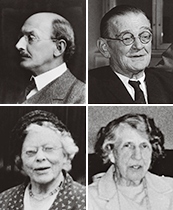





 The Topographical Bibliography of Ancient Egyptian Hieroglyphic Texts,
Statues, Reliefs and Paintings, (also known as Porter & Moss or
TopBib, as called in-house) is an essential and comprehensive reference
resource for Egyptologists, presenting and analysing both published and
unpublished information about ancient Egyptian monuments. The first seven
volumes are arranged topographically and cover the whole of Egypt and areas
beyond, including Nubia (southernmost modern Egypt and northern Sudan). Volume
8 addresses the significant body of material in museums and private
collections which has no certain provenance. Published in May 2014, the
current website is the digitised version of this project.
The Topographical Bibliography of Ancient Egyptian Hieroglyphic Texts,
Statues, Reliefs and Paintings, (also known as Porter & Moss or
TopBib, as called in-house) is an essential and comprehensive reference
resource for Egyptologists, presenting and analysing both published and
unpublished information about ancient Egyptian monuments. The first seven
volumes are arranged topographically and cover the whole of Egypt and areas
beyond, including Nubia (southernmost modern Egypt and northern Sudan). Volume
8 addresses the significant body of material in museums and private
collections which has no certain provenance. Published in May 2014, the
current website is the digitised version of this project.
The concept of a bibliography of Egyptian monuments arranged topographically was first proposed by the scholar and lexicographer Adolf Erman in the late 1890s, as a part of the scheme for the Berlin Wörterbuch. It was Francis Llewellyn Griffith, the first Professor of Egyptology at Oxford, who made the idea a reality by providing financial support and the resources of his private library.
Bertha Porter, a professional bibliographer, was employed by Griffith to analyse publications. After 20 years of collecting references an additional editor was sought. Rosalind Moss, a student of Griffith’s, gave the Bibliography the structure that we are familiar with today. Following Porter’s retirement in 1929, Moss was joined by Ethel Burney, and they edited the seven volumes which covered the whole of Egypt, Nubia and beyond. The later editorial partnership of Dr Moss and Mrs Burney has passed into Egyptological folklore; they are affectionately referred to as the ‘Two Ladies’, in reference to the ancient Egyptian goddesses of Upper and Lower Egypt. The Two Ladies were succeeded in 1971 by Jaromir Malek who revised the crucial Memphite volume and initiated a further 8th volume series for objects of provenance not known, an invaluable and timely expansion of the project’s scope. In August 2012, the editorship fell to Vincent Razanajao, who was given the challenging task to digitize the entire Topographical Bibliography. The current website presents the work done so far with the assistance of Francisco Bosch-Puche and Elizabeth Fleming.
Material for the Bibliography is gathered from an ever-expanding range of multi-lingual sources, encompassing both specialist and semi-popular Egyptological and Near Eastern publications, periodicals, museum guides, exhibition and auction catalogues, together with the growing wealth of web resources. The Bibliography also analyses a range of unpublished manuscripts, including those housed in the Griffith Institute Archive. The Bibliography volumes are constantly revised and augmented.
In addition to the published volumes, a vast amount of material collected for incorporation in future revisions is available for consultation by scholars. Approximately one million references are stored on handwritten ‘Appendix slips’, waiting to be digitized and edited for the new version of the project.